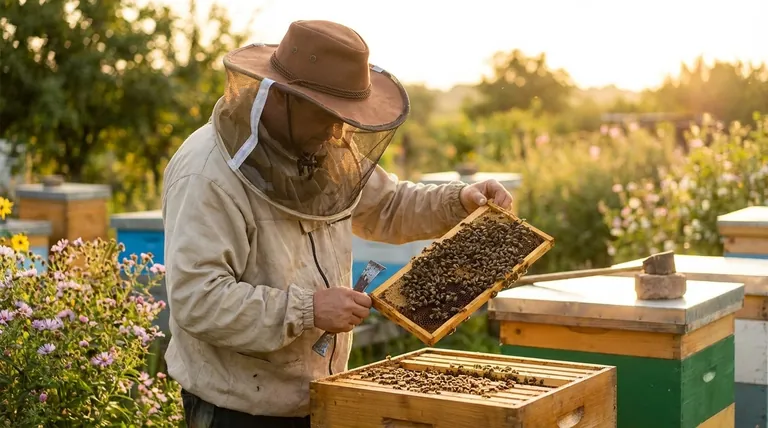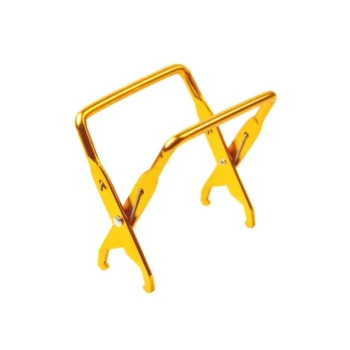In beekeeping, the helmet itself is quite simple. It is typically a rigid plastic or woven mesh structure designed to protect your head from bumps and, more importantly, to provide a stable frame that keeps the protective veil away from your face. The true decision you face is not about the helmet material, but about the style of veil that is attached to or paired with it.
The most critical choice in beekeeping headgear is not the helmet, but the style of the veil. Your decision between a Fencing, Round, or Square veil will determine your field of vision, ventilation, and overall comfort.

The Two Core Components: Helmet and Veil
Understanding your head protection means seeing it as a two-part system. Each part serves a distinct but interconnected purpose.
The Helmet's Role: Structure and Protection
The helmet is the foundation. Its primary job is to create a rigid space around your head.
This structure is what prevents the veil's mesh from touching your skin, which is essential for preventing stings. Helmets are typically made of durable plastic or a lighter woven mesh.
The Veil's Role: The Critical Barrier
The veil is the screen that encloses the helmet and protects your face and neck. This is where the most significant design differences exist.
The style of the veil dictates your experience more than any other factor, influencing how you see, how well air circulates, and how it connects to your suit.
Comparing the Primary Veil Styles
There are three dominant veil designs in modern beekeeping, each with a distinct profile and set of characteristics.
The Fencing Veil (Modern Standard)
This is the most popular style today, often integrated directly into a bee jacket or full suit with a zipper.
It features a structured design with supports that hold the mesh screen in a shape resembling a fencer's mask. This provides excellent forward visibility and a secure, sealed connection to your suit.
The Round Veil (Classic Choice)
The round veil is the most traditional design, resembling a wide-brimmed hat with mesh draping all the way around.
Its key advantage is offering an unobstructed, 360-degree field of view and superior ventilation due to its open design. It is held away from the face by the wide brim of the hat.
The Square Veil (The Folding Option)
The square veil is designed for portability and convenience. It uses internal wiring that allows it to be folded completely flat.
This makes it an excellent choice for a backup veil or for beekeepers with limited storage space. Despite its name, it provides a very wide, rectangular range of vision when worn.
Understanding the Trade-offs
Choosing the right veil style involves balancing competing benefits. What you gain in one area, you may sacrifice in another.
Vision vs. Integration
A round veil offers the best possible peripheral vision, which is ideal for situational awareness in the bee yard.
In contrast, a fencing veil provides a more secure, integrated fit with a suit, virtually eliminating any gaps for bees to enter, though its structure may slightly limit your side view.
Ventilation vs. Structure
The open, draped design of a round veil allows for maximum airflow, making it the most comfortable option in hot climates.
The fencing veil, while offering good airflow, can feel slightly more enclosed. Its rigid structure, however, is excellent at keeping the mesh consistently away from your face, even when bending over.
Portability vs. Durability
The defining feature of a square veil is its ability to fold flat, making it exceptionally portable.
A rigid plastic helmet paired with a round or fencing veil is bulkier but can offer more impact protection and may feel more substantial and durable during frequent use.
Making the Right Choice for Your Goal
Select your headgear based on your primary needs and beekeeping environment.
- If your primary focus is security and ease of use: Choose a Fencing Veil, especially one that zips directly onto a jacket or suit.
- If your primary focus is maximum ventilation and visibility: Choose a Round Veil, as its open design is unmatched for comfort in the heat and for maintaining peripheral awareness.
- If your primary focus is portability and having a reliable backup: Choose a Square Veil for its unique ability to fold flat for easy storage.
Ultimately, choosing the right headgear is about matching the veil's design to your specific needs in the apiary.
Summary Table:
| Veil Style | Best For | Key Feature |
|---|---|---|
| Fencing Veil | Security & Integration | Zips to suit; excellent forward vision |
| Round Veil | Ventilation & Visibility | 360° view; maximum airflow |
| Square Veil | Portability & Backup | Folds flat for easy storage |
Ready to equip your apiary with the right protective gear? HONESTBEE supplies durable beekeeping helmets and veils to commercial apiaries and distributors. We help you maximize safety and comfort for your team. Contact us today to discuss your wholesale needs!
Visual Guide

Related Products
- Heavy Duty Cowboy Beekeeper Hat with Visibility Veil Outdoor Professional Beekeeping Protective Gear
- High-Definition Beekeeper Hat with Round Veil Mesh for Beekeeping
- Beekeeping Gloves Goatskin Leather with Long Cotton Sleeve for Beekeepers
- Lightweight Aluminum Frame Grip
- Professional Galvanized Hive Strap with Secure Locking Buckle for Beekeeping
People Also Ask
- What are the benefits of the lightweight fabric used in the beekeeping hat veil? Enhanced Visibility & Comfort for Hive Work
- How does the design of the beekeeping hat ensure comfort during extended use? Maximize Comfort for Long Apiary Hours
- What is the purpose of the high visibility veil on the beekeeping hat? Ensure Maximum Safety and Clarity
- How can beekeeping supplies and accessories enhance the hobby? Essential Tools for Safe & Rewarding Beekeeping
- What features enhance the quality of the beekeeping veil? Choose the Right Protection for Your Apiary



















